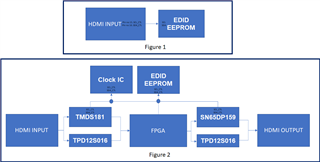Other Parts Discussed in Thread: TMDS181, TPD12S016, TMDS171
Hello,
We are planning to use SN65DP159 IC to convert the TMDSTm to HDMITm and then we have connected those signals with FPGA.
For the I2C & HPD, we have used the TPD12S016RKTR level shifter.
So Can we leave HPD & I2C pins (Pin no. #4,46,47,33,39,38) of SN65DP159 IC as floating ? If no then where to connect?
We have attached the image for reference.
Thanks,
Yamini





